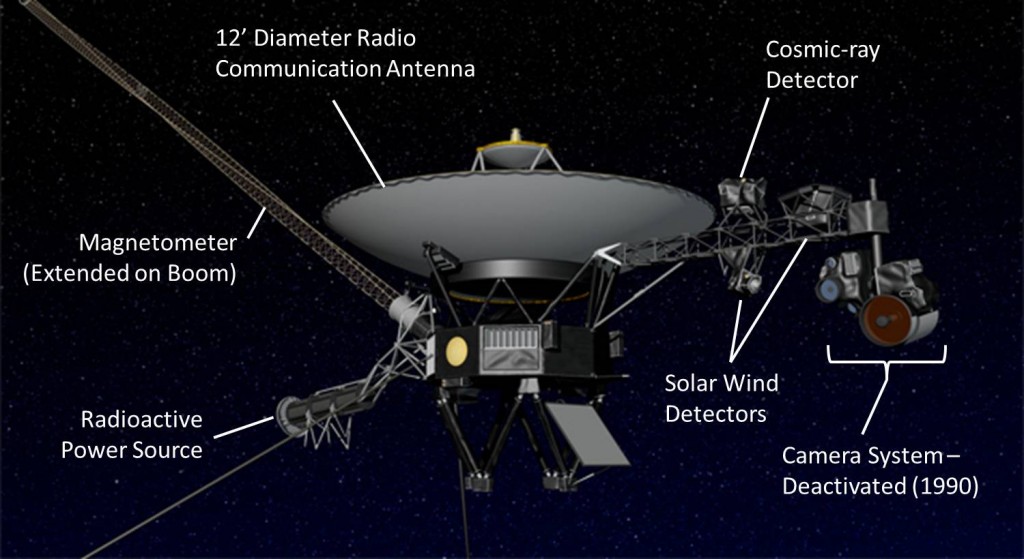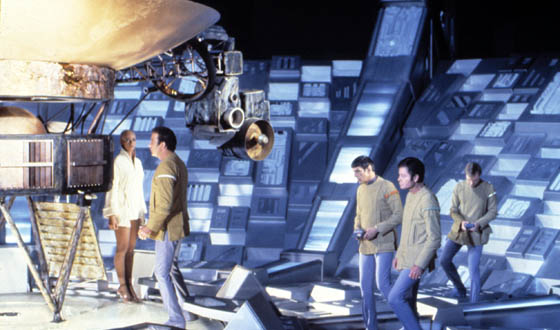As our closest astronomical neighbors, the planets have been subjects of keen observation by astronomers for over three millennia. The twin Voyager 1 and 2 spacecraft, built and launched in the 1970s, flew by Jupiter, Saturn, Uranus, and Neptune, and provided a wealth of data and photographs in the 1980s. But far beyond even the most distant planet lies an invisible boundary at the edge of the solar system. This boundary, called the heliopause, has been studied closely only within the past decade, and still holds many mysteries. The Voyager mission continues to this day as the probes hurtle toward the edge of the solar system, providing clues about this invisible boundary at distances never before visited by a human spacecraft.
Engineered for a Long Journey
The Voyagers have been traveling through the solar system for the past 35 years. For the first decade, they snapped photos and measured the atmospheres of the outer planets. They are now four times farther out than Neptune, the most distant planet. Although their cameras have been turned off, their other instruments continue to measure the invisible properties of the solar system and then beam this information back to Earth using a radio dish (Figure 1).
In order to gather data so far away from Earth, the probes’ designers faced some unique challenges, including figuring out how to power the probes. Working in deep space means that the sun is too distant to power the probes with solar panels. Instead, the Voyagers are powered by radioactive rods attached to the craft (Figure 1). As these radioactive materials decay, they produce heat, which is converted into electricity to power the probes’ instruments. This type of “radioactive battery” has a very predictable life span, so scientists are already planning for the eventual retirement of the probes. In 2020 the first of the scientific instruments will have to be turned off to conserve power, and by 2025 the Voyager probes will go completely silent [1].
With a limited amount of time to gather data, the probes must travel fast. Voyager 1 is currently traveling at a speed of 38,000 mph, a speed that would allow an airplane to circle the Earth one and half times per hour [2]. Even at this speed, the Voyagers require decades to reach the edge of the solar system because the distances in space are so great. Astronomers measure distances within the solar system in astronomical units (AU), where one AU equals the distance from the Earth to the sun. Voyager 1 is currently more than 120 times further away from the sun than the Earth at 120 AU, or about 10 billion miles. At this distance, radio communication with Voyager 1 takes an excruciating 17 hours each way, a process that takes only a second for Earth-orbiting satellites [3].
Figure 1: A diagram of NASA’s Voyager probes. The properties of the solar wind emanating from the sun are measured by a pair of detectors. The cosmic-ray detector senses high energy particles from outside the solar system. The magnetometer, which measures magnetic fields, is deployed at the end of a long boom to distance itself from magnetic fields generated by the spacecraft’s own electronics. All other instruments are currently deactivated. Adapted from NASA/JPL-CALTECH.
Solar Forces at the Edge of the Solar System
After their planetary flybys, the Voyager probes were flung out toward the edge of the solar system, with the hopes of crossing into the interstellar space that lies beyond. The boundary, called the heliopause, is generated by the interaction of forces emanating outwards from the sun with those coming inwards from the galaxy beyond.
The sun exerts its influence throughout the solar system not just through the light and heat it emits, but also via an outwardly streaming flow of sub-atomic charged particles, called the solar wind. The Earth is shielded from the solar wind by its strong magnetic field. Charged particles tend to follow the contours of a magnetic field, so around the Earth the solar wind is diverted towards the poles, where it interacts with the atmosphere to create nightly auroras. In a similar fashion, the solar wind in deep space follows the contours of the magnetic field generated by the sun.
Outside the solar system, the galaxy produces its own magnetic fields and has its own wind which flows through a diffuse gas called the interstellar medium. Where the outward pressure of the solar wind meets the inward pressure of the interstellar medium, the edge of a bubble is formed around the solar system (Figure 2). This bubble, called the heliosphere, turns out to be multilayered and more complex than originally theorized, which we now know thanks to data sent back from the Voyager probes.
Figure 2: An artist’s rendition of the shape of the edge of the solar system. The blue region is called the heliosphere, where the sun’s magnetic field and solar wind are still present. The orange region beyond the solar system is filled with different types of particles called the interstellar medium. Voyagers 1 and 2 have both passed through the termination shock boundary, and are now in the heliosheath. Voyager 1 has recently shown signs of passing into a “magnetic highway”, a region when the magnetic forces from inside and outside the heliopause link up. Much of this diagram is still theoretical, recent data suggests that the heliosphere is less elongated than shown here [4]. Adapted from NASA/JPL-CALTECH.
First Signs of the Edge
Among its original complement of instruments, there are four which Voyager currently uses to analyze the properties of the interstellar space (Figure 1). Two of the instruments are sensitive to the particles in the solar wind, and together are able to determine the density, velocity, and direction of the solar wind. A third instrument is sensitive only to the faster moving, more energetic particles from the interstellar medium, called cosmic rays. Finally, there is a magnetometer, which can measure the direction and strength of the magnetic field near Voyager [5].
The first signals that Voyager was nearing the edge of the solar system came in 2004, when it crossed a boundary called the termination shock (Figure 2). At this point, the outward flow of the solar wind begins to get impeded by the pressure from the interstellar medium. The solar wind, which is ejected from the sun at supersonic speeds, rapidly decelerates to a hotter, denser, and more stagnant flow at the termination shock [6]. However, the push of the solar wind and the influence of the sun’s magnetic field are still strong enough to prevent the inward flow of interstellar cosmic ray particles.
On December 16, 2004, after cruising 8 billion miles past Saturn, Voyager 1 received a jolt and crossed into the region beyond the termination shock, known as the heliosheath [7]. The probe’s instruments detected the tell-tale slowing of the solar wind associated with the crossing. Two and half years later, Voyager 2 also passed through the termination shock at a different point in space, confirming the results of the first probe. The Voyager 2 actually encountered the termination shock at a distance 10 AU closer to the sun the Voyager 1, meaning the shape of the termination shock is not spherical, but has been deformed for reasons that are still unknown [8].
Once in the heliosheath, both probes continued to return data on the properties of this never-before-studied region. The heliosheath could be up to several billion miles thick, so teams of scientists were forced to listen patiently for the better part of a decade for the next landmark signature from the edge of the solar system.
Coming Closer to the Edge
The first signs that Voyager 1 is reaching the edge came on August 25, 2012, although they were not what scientists were expecting. Scientists hypothesize that the solar wind will completely die off at the edge of the heliosheath, and that there will be a concurrent increase in the cosmic rays from outside the solar system. It is also expected that the probes will measure an abrupt kink in the magnetic field as they exit the region where the Sun’s field dominates and for the first time detect the magnetism from the galaxy.
Voyager 1 detected the first two signs of this transition out of the solar system, but not the shift in the magnetic field. This means Voyager 1 has entered a region never before theorized by heliophysicists. Dr. Edward Stone, project director of the Voyager probes since their launch, likens Voyager 1’s current location to a “magnetic highway”, where sun’s magnetic fields have somehow smoothly comingled with those from the galaxy [1]. This smooth transition provides a conduit for solar wind to get out and cosmic rays to get in. Without the predicted changes in the magnetic field, the scientific team has concluded that Voyager 1 still sits within the tenuous influence of the sun, and thus should still be considered inside the solar system [9].
In the decade remaining while Voyager 1 still has power, all ears are awaiting the signal that the probe has crossed the barrier and entered interstellar space. Of course Voyager 2 is also being closely watched, as within the next few years it may enter into a “magnetic highway” region of its own. Considering how surprising the “magnetic highway” is to scientists, it’s difficult to make predictions about just what Voyager 1 will encounter next. The edge of the solar system is a dynamic place, and thanks to both Voyagers we know far more now than we did when they first embarked on this journey 35 years ago.
Paul Hess is a Ph.D. candidate in Physics at Harvard University.





